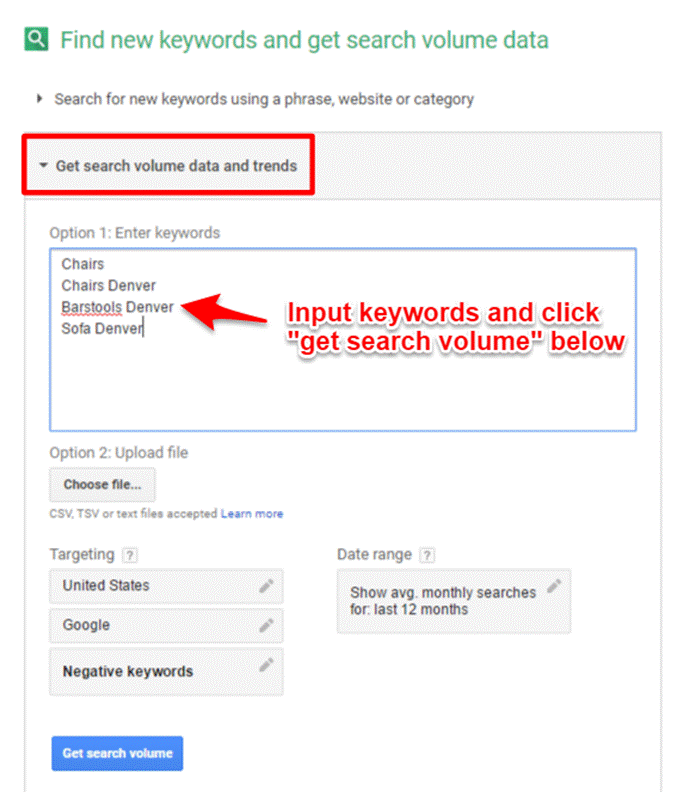
There are 3 primary components to keyword research: search volume, competition, and relevance.
Here we’ll explore each factor and its impact on keyword value.
Let’s get to it!
The 3 Components To Keyword Research
Component #1: Search Volume
How often is your keyword searched?
Valuable keywords are frequently searched. The greater the search volume, the more traffic the keyword can bring.
Use Google’s Keyword Planner to estimate search volume. Enter your target keyword, its variations, plurals, and other related keywords. 
Estimate the amount of traffic your site would get if you ranked for each keyword and its variations.

If you target “denver chairs” you’re also targeting “chairs denver”, “chairs in denver,” and maybe even “denver chairs store.”
Why? These searches yield similar search engine results. With one web page, you can target multiple related keywords if they fall under a single topic.
Include all variations and document your search volumes in a table.
| Target Keyword | Search Volume | Notes |
| Chairs | Chairs – 110,000
|
Note: When you search Google for “chairs” you find nothing for “seats.” For this reason, don’t include “seats” in your search volume. |
| Chairs Denver | Chairs Denver – 10 Denver chair – 40 |
Include all variations! |
| Barstools Denver | Bar stools Denver – 480 Denver barstools – 30 |
Apparently “bar stools” is more frequently searched than “barstools.” |
| Sofa Denver | Sofa Denver – 210 Denver sofa – 70 |
Now that we’ve got an idea of search frequency, let’s move on to component #2.
Component #2: Competition
Which domains rank for your target keyword?
If your competition is Wikipedia, Best Buy, and WalMart, your chances for success are slim to none.
Compare your domain authority using MozBar (it’s free) with websites that rank on the first page for your keyword.
When you activate the MozBar plugin, search Google for your keyword, and the search engine results page (SERP) will look like this.

Is there room for your domain?
If your website’s domain authority is 5, don’t target keywords that are dominated by websites with domain authorities in the 80’s and 90’s. Find something in your range.
Note: When gauging competition, check their title tags. If the competition doesn’t have a title tag that matches or closely relates to your target keyword, there is space for your content.
Don’t mistake this for a sure ranking, but note this search isn’t as heavily targeted as other search terms.
Now we have a better understanding of our keyword targets…
| Keyword | Search Volume | Competition |
| Chairs | 110,000 | Very High |
| Chairs Denver | 50 | Medium |
| Barstools Denver | 510 | Low |
| Sofa Denver | 280 | Low |
Component #3: Relevance
For obvious reasons, your target keyword must relate to your business.
Here are some questions to consider.
● How well-aligned is your keyword with your target audience?
● Is the person searching your keyword ready to buy?
● How much would this customer benefit you? Is the nature of their search broad and topical? Or is it specifically related to your product or service?
● Are they searching for your most expensive item? Or a low-cost service?
Answers to these questions can help you gauge your keyword’s relevance.
Here’s how we gauged the relevance for each of our original keywords.
| Keyword | Search Volume | Competition | Relevance |
| Chairs | 110,000 | Very High | High |
| Chairs Denver | 10 | Medium | Very High |
| Barstools Denver | 480 | Low | Very High |
| Sofa Denver | 210 | Low | Very High |
Keyword Research And Content Prioritization
Now that we’ve considered each attribute, let’s prioritize our keywords and content.
The priority estimation draws from each component: search volume, competition, and relevance.
| Keyword | Priority Estimation | Explanation |
| Chairs | 1/10 | Competition is way too high. As a store with several locations, you can’t compete with Target, Overstock, and Wayfair |
| Chairs Denver | 5/10 | Search volume is low, but consider local results. Google this keyphrase and you’ll find local results front-and-center. Local results are fed by Google My Business. If you haven’t already, create/beef up your listing. |
| Barstools Denver | 9/10 | There’s a lot of opportunity here! A solid number of searches, low competition, and high relevancy. Make sure you have a webpage on your site that targets this keyword! If you have your products online (which you should!) incorporate these keywords into your title tag. |
| Sofa Denver | 8/10 | More opportunity! Beware, however, this SERP currently has one domain in the top 3 spots. Multiple domains on the same SERP are grouped together. Given the current state of the SERP, the highest you could get is #4, unless you jump this domain to the #1 spot. |
How To Create A Content Schedule
Create a content schedule with target keywords for each piece of content.
Use the attributes and notes discussed in this article.
Gauge the potential value and competition of your keywords, and use this gauge as a benchmark to prioritize your content.
Let this guide your organic search campaigns. It’s easy to get sidetracked with ideas that sound good, but for organic search growth, they must pass the logic test.
Other Influencing Factors
Remember, quality content alone doesn’t necessarily translate to content marketing success. It’s a huge factor, but consider these others…
Link Profile
Websites need links to rank. Not every page needs a plethora of links to rank, but in most cases a website’s domain needs links to rank.
Keyword Niche
Websites that publish numerous pieces of quality content on the same topic are often looked as a “trusted source” for that topic. This can affect keyword ranking.
SERP Landscape
Certain searches lend themselves to different results. Local searches often display local results ported over from Google My Business listings. Some searches contain Google AdWords ads, leaving fewer clicks to organic search results.
Conclusion
The most important ranking factors are your content and your links.
Test each of your target keywords with each of the three components listed in this guide. Such planning will put you well on your way to successful content marketing and website growth.
Hand-Picked Related Articles:
- “People Who Bought This Also Bought” – Related Keyword Searches Unraveled
- 15 Factors to Consider When Prioritizing Which Keywords to Target
- Seasonal SEO 101: Look Ahead Without Fear
* Adapted lead image: ![]() Public Domain, pixabay.com via getstencil.com
Public Domain, pixabay.com via getstencil.com
The post Keyword Research Strategy: Search Volume, Competition & Relevance appeared first on Search Engine People Blog.
Search Engine People Blog(54)
Report Post






